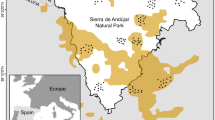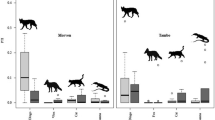Abstract
Top predators are declining globally, in turn allowing populations of smaller predators, or mesopredators, to increase and potentially have negative effects on biodiversity. However, detection of interactions among sympatric predators can be complicated by fluctuations in the background availability of resources in the environment, which may modify both the numbers of predators and the strengths of their interactions. Here, we first present a conceptual framework that predicts how top-down and bottom-up interactions may regulate sympatric predator populations in environments that experience resource pulses. We then test it using 2 years of remote-camera trapping data to uncover spatial and temporal interactions between a top predator, the dingo Canis dingo, and the mesopredatory European red fox Vulpes vulpes and feral cat Felis catus, during population booms, declines and busts in numbers of their prey in a model desert system. We found that dingoes predictably suppress abundances of the mesopredators and that the effects are strongest during declines and busts in prey numbers. Given that resource pulses are usually driven by large yet infrequent rains, we conclude that top predators like the dingo provide net benefits to prey populations by suppressing mesopredators during prolonged bust periods when prey populations are low and potentially vulnerable.





Similar content being viewed by others
References
Agostinelli C, Lund U (2013) R package ‘circular’: circular statistics (version 0.4–3). https://r-forge.r-project.org/projects/circular/
Aumann T (2001) Habitat use, temporal activity patterns and foraging behaviour of raptors in the south-west of the Northern Territory, Australia. Wildl Res 28:365–378
Billick I, Case TJ (1994) Higher order interactions in ecological communities: what are they and how can they be detected? Ecology 75:1529–1543
Brook LA, Johnson CN, Ritchie EG (2012) Effects of predator control on behaviour of an apex predator and indirect consequences for mesopredator suppression. J Appl Ecol 49:1278–1286
Caughley G (1987) Ecological relationships. In: Caughley G, Shepherd N, Short J (eds) Kangaroos: their ecology and management in the sheep rangelands of Australia. Cambridge University Press, New York, pp 159–187
Colman NJ, Gordon CE, Crowther MS, Letnic M (2014) Lethal control of an apex predator has unintended cascading effects on forest mammal assemblages. Proc R Soc B: Biol Sci 281
Cordeiro G, Paula G, Botter D (1994) Improved likelihood ratio tests for dispersion models. Int Stat Rev 62:257–274
Cozzi G, Broekhuis F, McNutt JW, Turnbull LA, Macdonald DW, Schmid B (2012) Fear of the dark or dinner by moonlight? Reduced temporal partitioning among Africa’s large carnivores. Ecology 93:2590–2599
Crowther MS, Fillios M, Colman N, Letnic M (2014) An updated description of the Australian dingo (Canis dingo Meyer, 1793). J Zool (in press)
Cupples JB, Crowther MS, Story G, Letnic M (2011) Dietary overlap and prey selectivity among sympatric carnivores: could dingoes suppress foxes through competition for prey? J Mammal 92:590–600
Dickman CR, Mahon PS, Masters P, Gibson DF (1999) Long-term dynamics of rodent populations in arid Australia: the influence of rainfall. Wildl Res 26:389–403
Dickman CR, Greenville AC, Beh C-L, Tamayo B, Wardle GM (2010) Social organization and movements of desert rodents during population “booms” and “busts” in central Australia. J Mammal 91:798–810
Donadio E, Buskirk SW (2006) Diet, morphology, and interspecific killing in carnivora. Am Nat 167:524–536
Elmhagen B, Rushton SP (2007) Trophic control of mesopredators in terrestrial ecosystems: top-down or bottom-up? Ecol Lett 10:197–206
Estes JA et al (2011) Trophic downgrading of planet Earth. Science 333:301–306
Fedriani JM, Fuller TK, Sauvajot RM, York EC (2000) Competition and intraguild predation among three sympatric Carnivores. Oecologia 125:258–270
Fleming PJS, Allen BL, Ballard G-A (2012) Seven considerations about dingoes as biodiversity engineers: the socioecological niches of dogs in Australia. Aust Mammal 34:119–131
Greenville AC, Dickman CR (2005) The ecology of Lerista labialis (Scincidae) in the Simpson Desert: reproduction and diet. J Arid Environ 60:611–625
Greenville AC, Wardle GM, Dickman CR (2012) Extreme climatic events drive mammal irruptions: regression analysis of 100-year trends in desert rainfall and temperature. Ecol Evol 2:2645–2658
Greenville AC, Wardle GM, Dickman CR (2013) Extreme rainfall events predict irruptions of rat plagues in central Australia. Aust Ecol 38:754–764
Jaksic FM, Silva SI, Meserve PL, Gutierrez JR (1997) A long-term study of vertebrate predator responses to an El Nino (ENSO) disturbance in western South America. Oikos 78:341–354
James CD (1991) Annual variation in reproductive cycles of scincid lizards (Ctenotus) in Central Australia. Copeia 1991:744–760
Johnson CN, VanDerWal J (2009) Evidence that dingoes limit abundance of a mesopredator in eastern Australian forests. J Appl Ecol 46:641–646
Johnson CN, Isaac JL, Fisher DO (2007) Rarity of a top predator triggers continent-wide collapse of mammal prey: dingoes and marsupials in Australia. Proc R Soc B: Biol Sci 274:341–346
Johnson CN, Ritchie EG et al (2013) The dingo and biodiversity conservation: response to Fleming et al. (2012). Aust Mammal 35:8–14
Kowalski M, Kowalski M (2012) EXIFPro 2.0, California
Letnic M, Dickman CR (2006) Boom means bust: interactions between the El Niño/Southern Oscillation (ENSO), rainfall and the processes threatening mammal species in arid Australia. Biodivers Conserv 15:3847–3880
Letnic M, Dickman CR (2010) Resource pulses and mammalian dynamics: conceptual models for hummock grasslands and other Australian desert habitats. Biol Rev 85:501–521
Letnic M, Koch F (2010) Are dingoes a trophic regulator in arid Australia? A comparison of mammal communities on either side of the dingo fence. Aust Ecol 35:167–175
Letnic M et al (2011) Does a top predator suppress the abundance of an invasive mesopredator at a continental scale? Glob Ecol Biogeogr 20:343–353
Letnic M, Ritchie EG, Dickman CR (2012) Top predators as biodiversity regulators: the dingo Canis lupus dingo as a case study. Biol Rev 87:390–413
Lundie-Jenkins G, Corbett L, Phillips C (1993) Ecology of the rufous hare-wallaby, Lagorchestes hirsutus Gould (Marsupialia: Macropodidae) in the Tanami Desert, Northern Territory. III. Interactions with introduced mammal species. Wildl Res 20:495–511
Mahon PS (1999) Predation by feral cats and red foxes and the dynamics of small mammal populations in arid Australia. Ph.D. thesis, University of Sydney, Sydney
Mahon PS, Banks PB, Dickman CR (1998) Population indices for wild carnivores: a critical study in sand-dune habitat, south-western Queensland. Wildl Res 25:11–22
Merkle JA, Stahler DR, Smith DW (2009) Interference competition between gray wolves and coyotes in Yellowstone National Park. Can J Zool 87:56–63
Molsher RL (1999) The ecology of feral cats, Felis catus, in open forest in New South Wales: interactions with food resources and foxes. Ph.D. thesis, University of Sydney, Sydney
Moseby KE, Neilly H, Read JL, Crisp HA (2012) Interactions between a top order predator and exotic mesopredators in the Australian rangelands. Int J Ecol, Article No. 250352
Palomares F, Caro TM (1999) Interspecific killing among mammalian carnivores. Am Nat 153:492–508
Paltridge R (2002) The diets of cats, foxes and dingoes in relation to prey availability in the Tanami Desert, Northern Territory. Wildl Res 29:389–403
Pavey CR, Eldridge SR, Heywood M (2008) Population dynamics and prey selection of native and introduced predators during a rodent outbreak in arid Australia. J Mammal 89:674–683
Pianka ER, King DR, King RA (2004) Varanoid lizards of the world. Indiana University Press, Indiana
Power ME (1992) Top-down and bottom-up forces in food webs: do plants have primacy? Ecology 73:733–746
Prugh LR et al (2009) The rise of the mesopredator. Bioscience 59:779–791
R Core Team (2013) R: A language and environment for statistical computing. R Foundation for Statistical Computing, Vienna
Ripple WJ, Beschta RL (2012) Trophic cascades in Yellowstone: the first 15 years after wolf reintroduction. Biol Conserv 145:205–213
Ripple WJ et al (2014) Status and ecological effects of the world’s largest carnivores. Science 343:1241484
Ritchie EG, Elmhagen B, Glen AS, Letnic M, Ludwig G, McDonald RA (2012) Ecosystem restoration with teeth: what role for predators? Trends Ecol Evol 27:265–271
Sinclair ARE, Pech RP, Dickman CR, Hik D, Mahon P, Newsome AE (1998) Predicting effects of predation on conservation of endangered prey. Conserv Biol 12:564–575
Smith AP, Quin DG (1996) Patterns and causes of extinction and decline in Australian conilurine rodents. Biol Conserv 77:243–267
Spencer EE, Crowther MS, Dickman CR (2014) Diet and prey selectivity of three species of sympatric mammalian predators in Central Australia. J Mammal (in press)
Tischler M, Dickman CR, Wardle GM (2013) Avian functional group responses to rainfall across four vegetation types in the Simpson Desert, Central Australia. Aust Ecol 38:809–819
Van Etten EJB (2009) Inter-annual rainfall variability of arid Australia: greater than elsewhere? Aust Geogr 40:109–120
Venables WN, Ripley BD (2002) Modern applied statistics with S, 4th edn. Springer, New York
Vine SJ et al (2009) Comparison of methods to detect rare and cryptic species: a case study using the red fox (Vulpes vulpes). Wildl Res 36:436–446
Ward D (2009) The biology of deserts. Oxford University Press, New York
White TCR (2008) The role of food, weather and climate in limiting the abundance of animals. Biol Rev 83:227–248
Yang LH, Edwards KF, Byrnes JE, Bastow JL, Wright AN, Spence KO (2010) A meta-analysis of resource pulse–consumer interactions. Ecol Monogr 80:125–151
Zuur AF (2009) Mixed effects models and extensions in ecology with R. Springer, New York, London
Acknowledgments
We thank Bush Heritage Australia and G. Woods for allowing access to the properties in the study region; members of the Desert Ecology Research Group, N. Hills, D. Nelson and G. Madani for valuable assistance in the field, and V. Nguyen for statistical advice. A. C. G. was supported by an Australian Postgraduate Award and Paddy Pallin Grant, Royal Zoological Society of NSW. Funding support for G. W. and C. D. was provided by the Australian Research Council and by the Australian Government’s Terrestrial Ecosystems Research Network (http://www.tern.gov.au), an Australian research infrastructure facility established under the National Collaborative Research Infrastructure Strategy and Education Infrastructure Fund—Super Science Initiative through the Department of Industry, Innovation, Science, Research and Tertiary Education.
Author information
Authors and Affiliations
Corresponding author
Additional information
Communicated by Ilpo Kojola.
Electronic supplementary material
Below is the link to the electronic supplementary material.
Rights and permissions
About this article
Cite this article
Greenville, A.C., Wardle, G.M., Tamayo, B. et al. Bottom-up and top-down processes interact to modify intraguild interactions in resource-pulse environments. Oecologia 175, 1349–1358 (2014). https://doi.org/10.1007/s00442-014-2977-8
Received:
Accepted:
Published:
Issue Date:
DOI: https://doi.org/10.1007/s00442-014-2977-8




